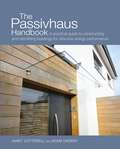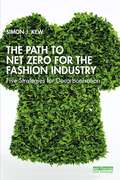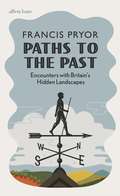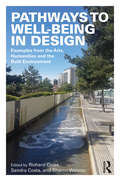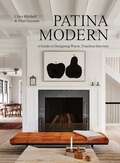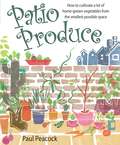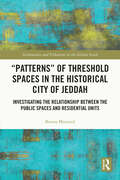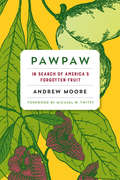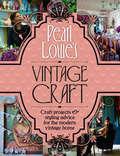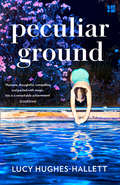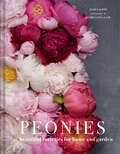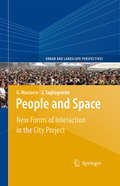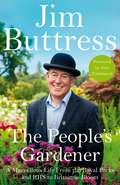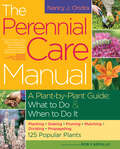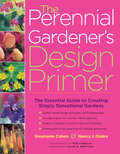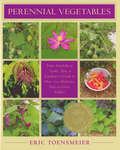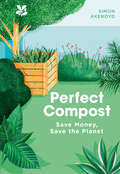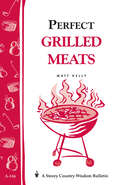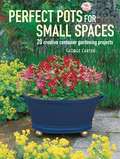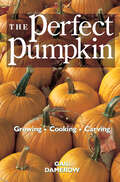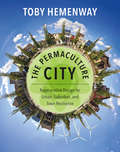- Table View
- List View
The Passivhaus Handbook: A practical guide to constructing and retrofitting buildings for ultra-low energy performance (Sustainable Building #4)
by Janet Cotterell Adam Dadeby'As we move towards the 2016 zero carbon target in house building, Passivhaus construction looks like becoming not just popular in the UK, but commonplace. This is a no-nonsense and engaging introduction on how to do it.' KEVIN MCCLOUD-The Passivhaus Handbook is an essential guide for anyone wanting to realise a supremely comfortable, healthy and durable home with exceptionally low energy costs. Passivhaus design focuses on getting the building fabric right, to achieve ultra-low energy consumption cost-effectively. The approach is relevant to a wide range of building types and climates. Its methodology can be combined with elements of other building standards, such as the UK's Code for Sustainable Homes (CSH), or with other sustainable building goals, such as a commitment to using low-impact or natural building materials.Whether you are building an extension, retrofitting your house or starting from scratch, and whether you are new to low-energy design or already have some experience, this book will help you navigate around the potential pitfalls and misconceptions. It brings together current thinking and best practice.The book includes a clear explanation of the underlying building physics and terminology, as well as detailed information on key elements of Passivhaus: avoiding air leakage, designing thermal (cold) bridges, moisture management and ventilation strategy. There is also lots of practical advice on setting up a project, including developing a motivated project team, and a discussion of economic considerations and the policy context in the UK. As pressure on global resources increases and energy prices continue to rise, the Passivhaus approach, proven over 20 years, meets the challenge of ultra-low-energy building for the future.
The Path to Net Zero for the Fashion Industry: Five Strategies for Decarbonisation
by Simon J. KewThis book uses a quantitative science-based approach to explain where the greenhouse gas (GHG) emissions emitted by the fashion industry are generated and it explores what strategies can be deployed to achieve Net Zero by 2050. With GHG emissions currently predicted to triple by the middle of the century, the fashion industry is far off course to reach Net Zero, as set out in the Paris Agreement. With misinformation and greenwashing representing an ever-growing barrier to potential solutions, the book aims to demystify the source of GHG emissions from the industry, breaking down in detail their origin, while identifying the steps that can be taken when designing and sourcing new products. Detailing the market drivers and trends in fashion consumption, it argues that change should be guided by science-based quantitative principles. Accessibly written with key insights at the end of each chapter, this book will enable the reader to understand the tactics to tackle decarbonisation, and ultimately outline five main strategies that can be deployed by the fashion and textile industries to align with the Paris Agreement. This book serves as a practical guide for designers, buyers and the fashion industry in general to develop and understand approaches and strategies to reduce energy consumption and the resulting GHG emissions to reach Net Zero.
The Path to Net Zero for the Fashion Industry: Five Strategies for Decarbonisation
by Simon J. KewThis book uses a quantitative science-based approach to explain where the greenhouse gas (GHG) emissions emitted by the fashion industry are generated and it explores what strategies can be deployed to achieve Net Zero by 2050. With GHG emissions currently predicted to triple by the middle of the century, the fashion industry is far off course to reach Net Zero, as set out in the Paris Agreement. With misinformation and greenwashing representing an ever-growing barrier to potential solutions, the book aims to demystify the source of GHG emissions from the industry, breaking down in detail their origin, while identifying the steps that can be taken when designing and sourcing new products. Detailing the market drivers and trends in fashion consumption, it argues that change should be guided by science-based quantitative principles. Accessibly written with key insights at the end of each chapter, this book will enable the reader to understand the tactics to tackle decarbonisation, and ultimately outline five main strategies that can be deployed by the fashion and textile industries to align with the Paris Agreement. This book serves as a practical guide for designers, buyers and the fashion industry in general to develop and understand approaches and strategies to reduce energy consumption and the resulting GHG emissions to reach Net Zero.
Paths to the Past: Encounters with Britain's Hidden Landscapes
by Francis PryorDiscover the hidden corners and forgotten crevices of Britain's landscapes, from lost rural treasures to unseen urban gems.Landscapes reflect and shape our behaviour. They make us who we are and bear witness to the shifting patterns of human life over the generations. Bringing to bear a lifetime's digging, archaeologist Francis Pryor delves into Britain's hidden urban and rural landscapes, from Whitby Abbey to the navvy camp at Risehill in Cumbria, from Tintagel to Tottenham's Broadwater Farm. Through fields, woods, moors, roads, tracks and towns, he reveals the stories of our physical surroundings and what they meant to the people who formed them, used them and lived in them. These landscapes, he stresses, are our common physical inheritance. If we can understand how to make them yield up their secrets, it will help us, their guardians, to maintain and shape them for future generations.
Pathways to Well-Being in Design: Examples from the Arts, Humanities and the Built Environment
by Richard Coles Sandra Costa Sharon WatsonHow can we achieve and promote well-being? Drawing on examples from the arts, humanities and design, this book brings together work from a wide range of areas to reveal the unique ways in which different disciplines approach the universal goal of supporting well-being. Pathways to Well-Being in Design recognises that the distinction between academics and practitioners often becomes blurred, where, when working together, a fusion of thoughts and ideas takes place and provides a powerful platform for dialogue. Providing new insights into the approaches and issues associated with promoting well-being, the book's multi-disciplinary coverage invites readers to consider these ideas within the framework of their own work. The book's 12 chapters are authored by academics who are involved in practice or are working with practitioners and features real world case studies which cover a range of situations, circumstances, environments, and social groups. Pathways to Well-Being in Design responds to those wishing to enquire further about well-being, taking the reader through different circumstances to consider approaches, discussing practice and theory, real world and virtual world considerations. This book is essential reading for anyone seeking to understand well-being, including students and professionals in architecture, landscape architecture, urban planning, design and health sciences.
Pathways to Well-Being in Design: Examples from the Arts, Humanities and the Built Environment
by Richard Coles Sandra Costa Sharon WatsonHow can we achieve and promote well-being? Drawing on examples from the arts, humanities and design, this book brings together work from a wide range of areas to reveal the unique ways in which different disciplines approach the universal goal of supporting well-being. Pathways to Well-Being in Design recognises that the distinction between academics and practitioners often becomes blurred, where, when working together, a fusion of thoughts and ideas takes place and provides a powerful platform for dialogue. Providing new insights into the approaches and issues associated with promoting well-being, the book's multi-disciplinary coverage invites readers to consider these ideas within the framework of their own work. The book's 12 chapters are authored by academics who are involved in practice or are working with practitioners and features real world case studies which cover a range of situations, circumstances, environments, and social groups. Pathways to Well-Being in Design responds to those wishing to enquire further about well-being, taking the reader through different circumstances to consider approaches, discussing practice and theory, real world and virtual world considerations. This book is essential reading for anyone seeking to understand well-being, including students and professionals in architecture, landscape architecture, urban planning, design and health sciences.
Patina Modern: A Guide to Designing Warm, Timeless Interiors
by Chris Mitchell Pilar GuzmánNamed one of Elle Decor&’s Best Coffee Table Books to Gift in 2022A tastemaking couple shares their playbook for creating a home that&’s both beautiful and comfortable Chris Mitchell and Pilar Guzmán are design obsessives who both want the same thing: rooms that are spare yet warm, layered yet clean, current yet timeless. Rooms that never forget the real humans—with all their needs, hopes, emotions, aspirations, and even spills—who live in these spaces. Over the course of six ever more ambitious home renovations, they&’ve cracked the code on how to achieve this. It&’s a simple formula, one that lies in mixing modern design with timeworn materials—in particular, white oak, brass, and bridle leather, all three of which become richer, mellower, and burnished with patina as they age. Add a few essential lessons (Decorating by Mood, Borrowing from the Best) and a nine-point manifesto that covers everything from lighting (rooms should feel like lanterns at night), to the use of black as an accent, to the intention that every space should serve multiple purposes, and the result is Patina Modern, a uniquely inspiring and practical design guide. The book leads by example, as the authors reveal in room-by-room detail the full evolution of their homes, including a Brooklyn brownstone and two classic Hamptons &“cottages.&” Along the way, we come to not only understand just how they see and think but also learn what they&’ve learned, getting an education in color, proportion, paint, and the world of modern furniture design, for which the authors have a special passion. Tools, principles, and the power of designing around the things you love—this is the gift of Patina Modern, showing just how to put it all together to create your own beautiful spaces.
Patio Produce: How to Cultivate a Lot of Home-grown Vegetables from the Smallest Possible Space
by Paul PeacockHow to cultivate a lot of home-grown vegetables from the smallest possible space. When space is at a premium, growing decent food to eat might seem an impossible task. Patio Produce is about just that; growing delicious, wholesome fruit and vegetables in the smallest spaces. It shows you how to make the most of pots and planters; how to create decorative but edible displays; how to plan for a reasonable yield; and how never to run out of at least something special to eat. If you have a balcony on a high rise, a roof garden or a patio, you can immeasurably enhance your quality of life, maintain your health and enjoy some amazing meals from the freshest and richest ingredients. Patio Produce goes from plant pot to plate. Think quality, freshness, flavour and put these thoughts into your ever greening fingers. Inside there are detailed step-by-step instructions how to grow on the patio - not just for novelty's sake, but for flavour and an enhanced eating experience. You might not have all the space in the world, but you can enjoy all the flavour in the world. To know you have grown, nurtured, harvested and cooked to perfection your own vegetables and fruit, will make this book into an old friend.
“Patterns” of Threshold Spaces in the Historical City of Jeddah: Investigating the Relationship Between the Public Spaces and Residential Units (Architecture and Urbanism in the Global South)
by Basma Massoud“Patterns” of Threshold Spaces in the Historical City of Jeddah explores the meaning of threshold spaces and investigates the relationship between the public spaces and residential units in the historical city of Jeddah, Saudi Arabia, while at the same time revisiting Christopher Alexander’s theory in his canonical 1977 book, A Pattern Language. This book questions and analyses “patterns” relating to the cultural, social, and environmental particularities of Jeddah, with special attention paid to the effect of gender segregation in the city’s urban configuration. It discusses the extension that has been undertaken through testing a concept from the urban design theory of the West (the United States and Canada) and applying it to an Islamic city to find patterns in four different scales, which form the basis of the investigation (body, building, street, and city). Empirical methods have been used in the context of historical Jeddah, through which patterns are investigated using different approaches for the different scales. The book aims to explore the meaning of threshold spaces in old Jeddah. Furthermore, it shows that there are eighteen patterns of threshold spaces in the old town: patterns that are solely related to this specific case study, as well as modified patterns to the ones explored by Christopher Alexander. This book shall allow not only a better understanding of the relationship between housing and the historical city but also an exploration of the role of the threshold space in shaping the old city of Jeddah. It will be of interest to researchers, students of architecture, urban planning and anthropology studies, and people involved in cultural heritage, both academics and practitioners.
“Patterns” of Threshold Spaces in the Historical City of Jeddah: Investigating the Relationship Between the Public Spaces and Residential Units (Architecture and Urbanism in the Global South)
by Basma Massoud“Patterns” of Threshold Spaces in the Historical City of Jeddah explores the meaning of threshold spaces and investigates the relationship between the public spaces and residential units in the historical city of Jeddah, Saudi Arabia, while at the same time revisiting Christopher Alexander’s theory in his canonical 1977 book, A Pattern Language. This book questions and analyses “patterns” relating to the cultural, social, and environmental particularities of Jeddah, with special attention paid to the effect of gender segregation in the city’s urban configuration. It discusses the extension that has been undertaken through testing a concept from the urban design theory of the West (the United States and Canada) and applying it to an Islamic city to find patterns in four different scales, which form the basis of the investigation (body, building, street, and city). Empirical methods have been used in the context of historical Jeddah, through which patterns are investigated using different approaches for the different scales. The book aims to explore the meaning of threshold spaces in old Jeddah. Furthermore, it shows that there are eighteen patterns of threshold spaces in the old town: patterns that are solely related to this specific case study, as well as modified patterns to the ones explored by Christopher Alexander. This book shall allow not only a better understanding of the relationship between housing and the historical city but also an exploration of the role of the threshold space in shaping the old city of Jeddah. It will be of interest to researchers, students of architecture, urban planning and anthropology studies, and people involved in cultural heritage, both academics and practitioners.
Pawpaw: In Search of America’s Forgotten Fruit
by Andrew Moore Michael W. TwittyThe largest edible fruit native to the United States tastes like a cross between a banana and a mango. It grows wild in twenty-six states, gracing Eastern forests each fall with sweet-smelling, tropical-flavored abundance. Historically, it fed and sustained Native Americans and European explorers, presidents, and enslaved African Americans, inspiring folk songs, poetry, and scores of place names from Georgia to Illinois. Its trees are an organic grower’s dream, requiring no pesticides or herbicides to thrive, and containing compounds that are among the most potent anticancer agents yet discovered. So why have so few people heard of the pawpaw, much less tasted one? In Pawpaw—a 2016 James Beard Foundation Award nominee in the Writing & Literature category—author Andrew Moore explores the past, present, and future of this unique fruit, traveling from the Ozarks to Monticello; canoeing the lower Mississippi in search of wild fruit; drinking pawpaw beer in Durham, North Carolina; tracking down lost cultivars in Appalachian hollers; and helping out during harvest season in a Maryland orchard. Along the way, he gathers pawpaw lore and knowledge not only from the plant breeders and horticulturists working to bring pawpaws into the mainstream (including Neal Peterson, known in pawpaw circles as the fruit’s own “Johnny Pawpawseed”), but also regular folks who remember eating them in the woods as kids, but haven’t had one in over fifty years. As much as Pawpaw is a compendium of pawpaw knowledge, it also plumbs deeper questions about American foodways—how economic, biologic, and cultural forces combine, leading us to eat what we eat, and sometimes to ignore the incredible, delicious food growing all around us. If you haven’t yet eaten a pawpaw, this book won’t let you rest until you do.
Pearl Lowe’s Vintage Craft: Craft Project And Styling Advice For The Modern Vintage Home
by Pearl LoweVintage designer Pearl Lowe shows you how to create the authentic vintage look in your own home with her expert advice and simple craft projects.
Peculiar Ground: A Novel
by Lucy Hughes-Hallett‘One of the best novels of the year so far’ The Times A SPECTATOR BOOK OF THE YEAR ‘Unlike anything I’ve read. Haunting and huge, and funny and sensuous. It’s wonderful’ Tessa Hadley ‘I just enjoyed it so very much’ Philip Pullman
Peonies: Beautiful Varieties For Home And Garden
by Jane Eastoe Georgianna LaneThis is first follow-up to the Garden Writer’s Guild Award-nominated Vintage Roses. This new title in Pavilion’s series of stylish floral gardening guides celebrates the beauty and versatility of the peony flower.
People and Space: New Forms of Interaction in the City Project (Urban and Landscape Perspectives #5)
by Giovanni Maciocco Silvano TagliagambeThis book explores new forms and modalities of relations between people and space that increasingly affect the life of the city. The investigation takes as its starting point the idea that in contemporary societies the loss of our relationship with place is a symptom of a breakdown in the relationship between ethics and aesthetics. This in turn has caused a crisis not only in taste, but also in our sense of beauty, our aesthetic instinct, and our moral values. It has also led to the loss of our engagement with the landscape, which is essential for cities to function. The authors argue that new, fertile forms of interaction between people and space are now happening in what they call the ‘intermediate space’, at the border of “urban normality” and those parts of a city where citizens experiment with unconventional social practices. This new interaction engenders a collective conscience, giving a new and productive vigor to the actions of individuals and also their relations with their environment. These new relations emerge only after we abandon what is called the “therapeutic illusion of space”, which still exists today, and which binds in a deterministic manner the quality of civitas, the associative life of people in the city, to the quality of urban space. Projects for the city should, instead, have as their keystone the notion of social action as a return to a critical perspective, to a courageous acceptance of social responsibility, at the same time as seeking the generative structures of urban life in which civitas and urbs again acknowledge each other.
The People's Gardener
by Jim ButtressWith an introduction by Alan Titchmarsh, The People's Gardener is an inspiring memoir by top gardening judge Jim Buttress, that will amuse and enthral gardeners everywhere.As a judge at the RHS, Jim Buttress presides over the country's favourite flower shows, including Chelsea and Hampton Court. He also judged the Britain in Bloom competition for over twenty-five years, and was watched by millions on the BBC's The Big Allotment Challenge. But how did this practical gardener from Purley go on to have one of the most impressive careers in British horticulture?In this warm and funny memoir, Jim takes us from his boyhood obsession with Percy Thrower to his ten-year stint as Superintendent of the Central Royal Parks. Here, his day-to-day duties could include anything from having a drink and a chat with the Queen Mother to working out how to water some elephants who'd taken up residence in Hyde Park.Jim also reveals what it's like to exhibit, and to win gold, at the Chelsea Flower Show, and shares his many adventures as a judge; from the joy of awarding medals to grateful winners to the shock of being threatened with a punch on the nose from the odd irate loser. Packed with brilliant characters, this book will delight everyone who shares Jim's love of gardening.
The Perennial Care Manual: A Plant-by-Plant Guide: What to Do & When to Do It
by Nancy J. OndraKeep your perennial beds looking their best, season after season. From planning and planting to pruning and propagating, this comprehensive guide covers everything you need to know to maintain a stunning perennial garden. Nancy J. Ondra provides an in-depth, plant-by-plant guide that profiles 125 popular perennials, with helpful information on each plant&’s soil, light, and water needs. Ondra&’s expertise and passion for gardening, along with Rob Cardillo&’s breathtaking photography, will inspire you to create a garden of your dreams that will last a lifetime.
The Perennial Gardener's Design Primer: The Essential Guide To Creating Simply Sensational Gardens
by Stephanie Cohen Nancy J. OndraTurn your outdoor landscape into a rich, living canvas of color and texture. Encouraging experimentation, Stephanie Cohen and Nancy J. Ondra show you how to plan a garden that incorporates unique combinations of plants to achieve stunning effects. With an overview of garden design fundamentals and 20 sample garden plans, Cohen and Ondra will inspire you to play with creative juxtapositions of vibrant hues and subtle textures. Let your imagination run wild as you create your own unique and original garden designs.
Perennial Vegetables: From Artichokes to Zuiki Taro, A Gardener's Guide to Over 100 Delicious and Easy to Grow Edibles
by Eric ToensmeierThere is a fantastic array of vegetables you can grow in your garden, and not all of them are annuals. In Perennial Vegetables the adventurous gardener will find information, tips, and sound advice on less common edibles that will make any garden a perpetual, low-maintenance source of food. Imagine growing vegetables that require just about the same amount of care as the flowers in your perennial beds and borders—no annual tilling and potting and planting. They thrive and produce abundant and nutritious crops throughout the season. It sounds too good to be true, but in Perennial Vegetables author and plant specialist Eric Toensmeier (Edible Forest Gardens) introduces gardeners to a world of little-known and wholly underappreciated plants. Ranging beyond the usual suspects (asparagus, rhubarb, and artichoke) to include such "minor" crops as ground cherry and ramps (both of which have found their way onto exclusive restaurant menus) and the much sought after, anti-oxidant-rich wolfberry (also known as goji berries), Toensmeier explains how to raise, tend, harvest, and cook with plants that yield great crops and satisfaction. Perennial vegetables are perfect as part of an edible landscape plan or permaculture garden. Profiling more than 100 species, illustrated with dozens of color photographs and illustrations, and filled with valuable growing tips, recipes, and resources, Perennial Vegetables is a groundbreaking and ground-healing book that will open the eyes of gardeners everywhere to the exciting world of edible perennials.
Perfect Compost: A Practical Guide
by Simon Akeroyd National Trust BooksLearn how to make and use nourishing compost for your garden with this handy little guidebook from an experienced National Trust head gardener.
Perfect Grilled Meats: Storey's Country Wisdom Bulletin A-146 (Storey Country Wisdom Bulletin)
by Matt KellySince 1973, Storey's Country Wisdom Bulletins have offered practical, hands-on instructions designed to help readers master dozens of country living skills quickly and easily. There are now more than 170 titles in this series, and their remarkable popularity reflects the common desire of country and city dwellers alike to cultivate personal independence in everyday life.
Perfect Money Saving (The\perfect Ser.)
by Smita Talati- Do you find you're always strapped for cash at the end of the month?- Are you worried about paying your credit card bills?- Would you like some practical advice on how to make your money go further?Perfect Money Saving is the essential guide for anyone who wants to take control of their finances. Covering everything from home-made presents to cheaper mortgages, it gives step-by-step guidance on how to cut your costs without giving up the things you enjoy. With sections on debt management and your financial portfolio, as well as a month-by-month breakdown showing where and when to grab the best bargains, Perfect Money Saving has all you need to make the most of every penny.The Perfect series is a range of practical guides that give clear and straightforward advice on everything from getting your first job to choosing your baby's name. Written by experienced authors offering tried-and-tested tips, each book contains all you need to get it right first time.
Perfect Pots for Small Spaces: 20 creative container gardening projects
by George CarterCombining inspiration with practicality, Perfect Pots for Small Spaces offers 20 exciting projects, each simple enough to complete in a weekend.Containers come in all sorts of materials, sizes and shapes, and can be used to enhance any outdoor space, from a small terrace to a large garden. In this highly informative and superbly illustrated book, award-winning gardener George Carter explains how to make the most of them. Divided into four sections – on terra cotta, masonry, metal and wood – it has step-by-step instructions and ideas for seasonal planting plans that make container gardening accessible to all. Among the imaginative projects are painted pots, a wirework hanging basket, a rustic window box, a trough with trellis screen, a wooden obelisk and a painted galvanised washtub. The projects are complemented by a plant directory, information on care and maintenance of containers and plants and an extensive list of resources.
The Perfect Pumpkin: Growing/Cooking/Carving
by Gail DamerowThe big orange pumpkin is no longer just for Halloween! Gail Damerow shows you how to cultivate more than 95 varieties of pumpkin, and provides recipes for pumpkin pies, muffins, and even pumpkin beer. You&’ll also learn how to use pumpkins in a variety of craft projects, from carving unique jack-o&’-lanterns to creating pumpkin-scented creams and soaps. With tips on growing giant pumpkins, preserving your harvest through the winter, and much more, The Perfect Pumpkin will delight pumpkin lovers of all sensibilities.
The Permaculture City: Regenerative Design for Urban, Suburban, and Town Resilience
by Toby HemenwayPermaculture is more than just the latest buzzword; it offers positive solutions for many of the environmental and social challenges confronting us. And nowhere are those remedies more needed and desired than in our cities. The Permaculture City provides a new way of thinking about urban living, with practical examples for creating abundant food, energy security, close-knit communities, local and meaningful livelihoods, and sustainable policies in our cities and towns. The same nature-based approach that works so beautifully for growing food—connecting the pieces of the landscape together in harmonious ways—applies perfectly to many of our other needs. Toby Hemenway, one of the leading practitioners and teachers of permaculture design, illuminates a new way forward through examples of edge-pushing innovations, along with a deeply holistic conceptual framework for our cities, towns, and suburbs. The Permaculture City begins in the garden but takes what we have learned there and applies it to a much broader range of human experience; we’re not just gardening plants but people, neighborhoods, and even cultures. Hemenway lays out how permaculture design can help towndwellers solve the challenges of meeting our needs for food, water, shelter, energy, community, and livelihood in sustainable, resilient ways. Readers will find new information on designing the urban home garden and strategies for gardening in community, rethinking our water and energy systems, learning the difference between a “job” and a “livelihood,” and the importance of placemaking and an empowered community. This important book documents the rise of a new sophistication, depth, and diversity in the approaches and thinking of permaculture designers and practitioners. Understanding nature can do more than improve how we grow, make, or consume things; it can also teach us how to cooperate, make decisions, and arrive at good solutions.
